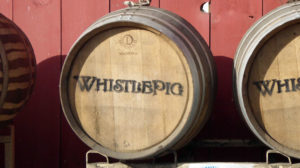Craft Whiskey In Crafty Vermont
By Richard Thomas
Vermont is a little state. Only Wyoming has fewer people in it, and in geographic size it is typical of the small states of New England. Yet that little place is renowned for its natural splendor, and that combined with an iconoclastic streak have given rise to Vermont having a reputation for craftiness in many things. Charming B&Bs in place of branded hotels; maple syrup by the tanker load; Ben & Jerry’s ice cream. The Green Mountain State is synonymous with well-made, authentic, crafty handiwork.
It only follows that Vermont would have an outsized compliment of small whiskey-making distilleries relative to its population. This being Vermont, the use of locally farmed grain is widespread. In fact, Vermont has more than a few throwbacks to the farmer-distiller model, with some at least partly reliant on grain from their own fields. Even when that is not the case, “locally sourced grain” has a much tighter meaning, with the grain coming not just from Vermont, but from the same or a neighboring county. Finally, as one might expect, a lot of Vermont distillers make use of the state’s famed maple syrup for making whiskey liqueurs.
Appalachian Gap Distillery
This solar-powered Middlebury distillery produces a no-dominant grain style of American whiskey (45% barley, 30% corn, 25% rye) that goes on to become a 108 proof white whiskey, Snowfall, and the 98-proof Ridgeline. The latter is matured in a mix of new oak barrels, ex-bourbon barrels, and port wine barrels.
Caledonia Spirits
These folks have named themselves after their locale, Caledonia County, and aren’t making an overt effort to channel Scotland. Many craft distilleries are the outgrowth of a brewery, winery or farm; Todd Harrie’s operation started as an outgrowth of his apiary. Even after partnering with Ryan Christiansen, a local homebrewing shopkeeper, they still operated as, in essence, home distillers with a 15-gallon direct-fired pot still for years before making the jump to proper micro-distillery in 2013, with the acquisition of a 300-gallon gin still.

(Credit: Kurt Maitland)
Where whiskey enters the picture is with last year’s purchase of a 500-gallon hybrid still, and with it a production run of rye whiskey. None of that is on the market yet (no white whiskey), but it is in the barrels and maturing.
Mad River Distillers
Started in 2011, Mad River has become one of the big figures in Vermont’s craft whiskey scene. More than likely if you are living outside of Vermont and you know of a Vermont whiskey that isn’t WhistlePig, it’s this one.
Located up in the Green Mountains, the distillery is in a renovated 19th Century barn and is plump with bucolic charm. Distilleries in barns are actually a thing in Vermont, but Mad River’s old barn is like something out of a picture postcard. Mad River has a range of products, including a bourbon, a rye and a single malt, and distribution throughout New England.
Silo Distillery
Situated in a stylishly renovated barn (now with a patio for visitors) in Windsor, Silo has been making whiskey since 2013. If Windsor sounds familiar, it’s the same town where you will find Harpoon Brewery, Green River Outfitters and The Cheese Board. They have a no malted barley, rye and corn only bourbon; a no dominant grain style American whiskey (presumably 50% corn and 50% rye); and a maple-flavored whiskey derived from that American whiskey.
Smuggler’s Notch Distillery
A father and son operation, Smuggler’s Notch has a bourbon, a wheat whiskey, and a maple-infused bourbon.
Vermont Spirits
This micro-distillery started out with vodka and kept at that for some years, but then put out a 100% corn whiskey. They also have a maple-infused bourbon, based on 5 year old sourced bourbon.
WhistlePig
Some will think it ironic that the biggest name in Vermont craft whiskey started out as an independent bottler, got a relatively late start, and currently does not have a completely in-house whiskey out as of yet. Yet WhistlePig has that big name precisely because they built their brand on the back of a stock of excellent rye whiskey imported from Canada while they worked on opening their distillery, proving once again the fundamental wisdom of the “early bird gets the worm” logic of the bottler-to-distiller model.
WhistlePig’s farm distillery went operational in 2015, and the company survived a corporate coup in 2016 to continue under its founder, Raj Bhakta. They introduced their first product using some in-house spirit earlier this year, Farmstock Crop 001. Presumably, WhistlePig will release follow-on crops using more and older homemade rye whiskey until they are ready to put out an expression that is 100% their own.




It’s not the Granite State…that’s New Hampshire. It’s the Green Mountain State
Yes, I had a brain fart this morning and called it that in the caption for our Facebook posting. But I had a clearer head when I wrote the article; no mention of granite there!